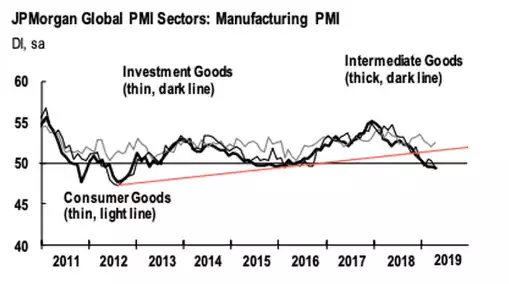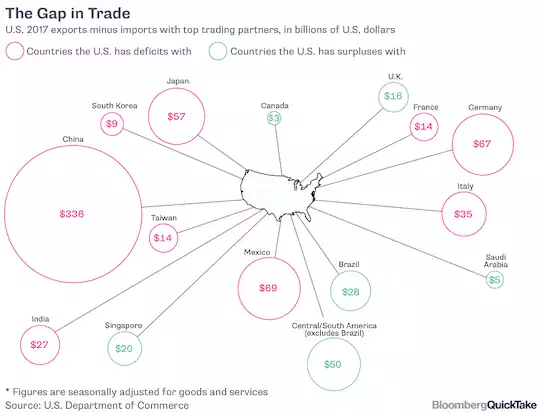US v China Trade War – The Big Picture
News
|
Posted 09/05/2019
|
8774
Off the back of the heavy losses on Wall St Tuesday night, we saw an absolute roller coaster last night, ending in the S&P500 down again. Just like Tuesday night, the roller coaster last night was on the eternal on again off again ‘news’ of the US / China trade deal. Reinforcing the widespread impact of this trade war, last night we saw JP Morgan’s latest Global Manufacturing PMI print a barely expansionary 50.3. Per the chart below, you can see the only thing keeping it in the black (above 50) is the blind faith spending of the current consumer…

Much has been written about the US / China trade deal, and the wider trade tensions globally. However Jim Rickards penned this great summary for The Daily Reckoning this week and it is very much worth reading for the more macro view that Rickards often brings to such analysis. Its well worth a read and posted verbatim below.
“The Trade War Is Back
President Trump shocked markets yesterday when he announced that a new, heavy round of tariffs on Chinese goods will take effect this Friday. Complacent markets had assumed that a trade deal would get done, that it was just a matter of sorting out the details. Now that is far from certain. Failing a last minute deal, which is certainly possible, the trade war is back. And it could get worse.
What most surprised me about the new trade war was not that it started, but that the mainstream financial media denied it was happening for so long. The media have consistently denied the impact of this trade war. Early headlines said that Trump was bluffing and would not follow through on the tariffs. He did. Later headlines said that China was just trying to save face and would not retaliate. They did.
Today the story line has been that the trade war will not have a large impact on macroeconomic growth. It will. The mainstream media have been wrong in their analysis at every stage of this trade war. And it did not see this latest salvo coming.
The bottom line is that the trade war is here, it’s highly impactful and it could get worse. The sooner investors and policymakers internalize that reality, the better off they’ll be.
For years I’ve been warning my readers that a global trade war was likely in the wake of the currency wars. This forecast seemed like a stretch to many. But it wasn’t.
I said it would simply be a replay of the sequence that prevailed from 1921–39 as the original currency war started by Weimar Germany morphed into trade wars started by the United States and finally shooting wars started by Japan in Asia and Germany in Europe.
The existing currency war started in 2010 with Obama’s National Export Initiative, which led directly to the cheapest dollar in history by August 2011. The currency war evolved into a trade war by January 2018, when Trump announced tariffs on solar panels and appliances mostly from China. Unfortunately, a shooting war cannot be ruled out given rising geopolitical tensions.
The reasons the currency war and trade war today are repeating the 1921–39 sequence are not hard to discern. Countries resort to currency wars when they face a global situation of too much debt and not enough growth.
Currency wars are a way to steal growth from trading partners by reducing the cost of exports. The problem is that this tactic does not work because trade partners retaliate by reducing the value of their own currencies. This competitive devaluation goes back and forth for years.
Everyone is worse off and no one wins.
Once leaders realize the currency wars are not working, they pivot to trade wars. The dynamic is the same. One country imposes tariffs on imports from another country. The idea is to reduce imports and the trade deficit, which improves growth. But the end result is the same as a currency war. Trade partners retaliate and everyone is worse off as global trade shrinks.
The currency wars and trade wars can exist side by side as they do today. Eventually, both financial tactics fail and the original problem of debt and growth persists. At that point, shooting wars emerge. Shooting wars do solve the problem because the winning side increases production and the losing side has infrastructure destroyed that needs to be rebuilt after the war.
Yet the human cost is high. The potential for shooting wars exists in North Korea, the South China Sea, Taiwan, Israel, Iran, Venezuela and elsewhere. Let’s hope things don’t get that far this time.
But the easiest way to understand the trade war dynamics is to take Trump at his word. Trump was not posturing or bluffing. He will agree to trade deals, but only on terms that improve the outlook for jobs and growth in the U.S. Trump is not a globalist; he’s a nationalist. That may not be popular among the elites, but that’s how he sets policy. Keeping that in mind will help with trade war analysis and predictions.
Trump is entirely focused on the U.S. trade deficit. He does not care about global supply chains or least-cost production. He cares about U.S. growth, and one way to increase growth is to reduce the trade deficit. That makes Trump’s trade policy a simple numbers game rather than a complicated multilateral puzzle palace.
If the U.S. can gain jobs at the expense of Korea or Vietnam, then Trump will do it; too bad for Korea and Vietnam. From there, the next step is to consider what’s causing the U.S. trade deficit. This chart tells the story. It shows the composite U.S. trade deficit broken down by specific trading partners:

The problem quickly becomes obvious. The U.S. trade deficit is due almost entirely to four trading partners: China, Mexico, Japan and Germany. Of those, China is 64% of the total.
President Trump has concluded a trade deal with Mexico that benefits both countries and will lead to a reduced trade deficit as Mexico buys more U.S. soybeans.
The U.S. has good relations with Japan and much U.S.-Japanese trade is already governed by agreements acceptable to both sides. This means the U.S. trade deficit problem is confined to China and Germany (often referred to euphemistically as “Europe” or the “EU”). The atmosphere between the U.S. and the EU when it comes to trade is still uneasy, but not critical.
But the global trade war is not global at all but really a slugfest between the U.S. and China, the world’s two largest economies. In the realm of global trade, the United States is an extremely desirable customer. In fact, for most, we are their best customer.
Think the still export-based Chinese economy can afford to sell significantly less manufactured goods across borders? Think that same Chinese economy can allow for a significant devaluation of U.S. sovereign debt? That’s their book, gang.
But China has finally come to the realization that the trade war is real and here to stay. Senior Chinese policymakers have referred to the trade war as part of a larger strategy of containment of Chinese ambitions that may lead to a new Cold War. They’re right.
Trump seems to relish the idea of bullying the Chinese in public. That’s certainly his style, but it’s also a risky strategy. To quote Sun Tzu: “Do not press a desperate foe too hard.”
China doesn’t like to be chastised publicly any more than anyone else, but culturally, saving-face may be more important to the Chinese. The Chinese are all about saving face and gaining face. That means they can walk away from a trade deal even if it damages them economically. Saving face is too important. But Trump is playing for keeps and will not back down either.
Unlike in other policy arenas, Trump has enjoyed bipartisan support in Congress. The Republicans have backed Trump from a national security perspective and the Democrats have backed him from a pro-labor perspective. China sees the handwriting on the wall.
This trade war will not end soon, because it’s part of something bigger and much more difficult to resolve. This is a struggle for hegemony in the 21st century. The trade war will be good for U.S. jobs but bad for global output. The stock market is going to wake up to this reality. The currency wars and trade wars are set to get worse.
Investors should prepare.”
We wrote yesterday about Australia still actively participating in the currency war. You can read that here.
Rickards and others have written extensively about China’s massive accumulation of gold since 2013 as a direct play to a strategic fall back should this war get out of hand and those US Treasuries they hold become weapons.